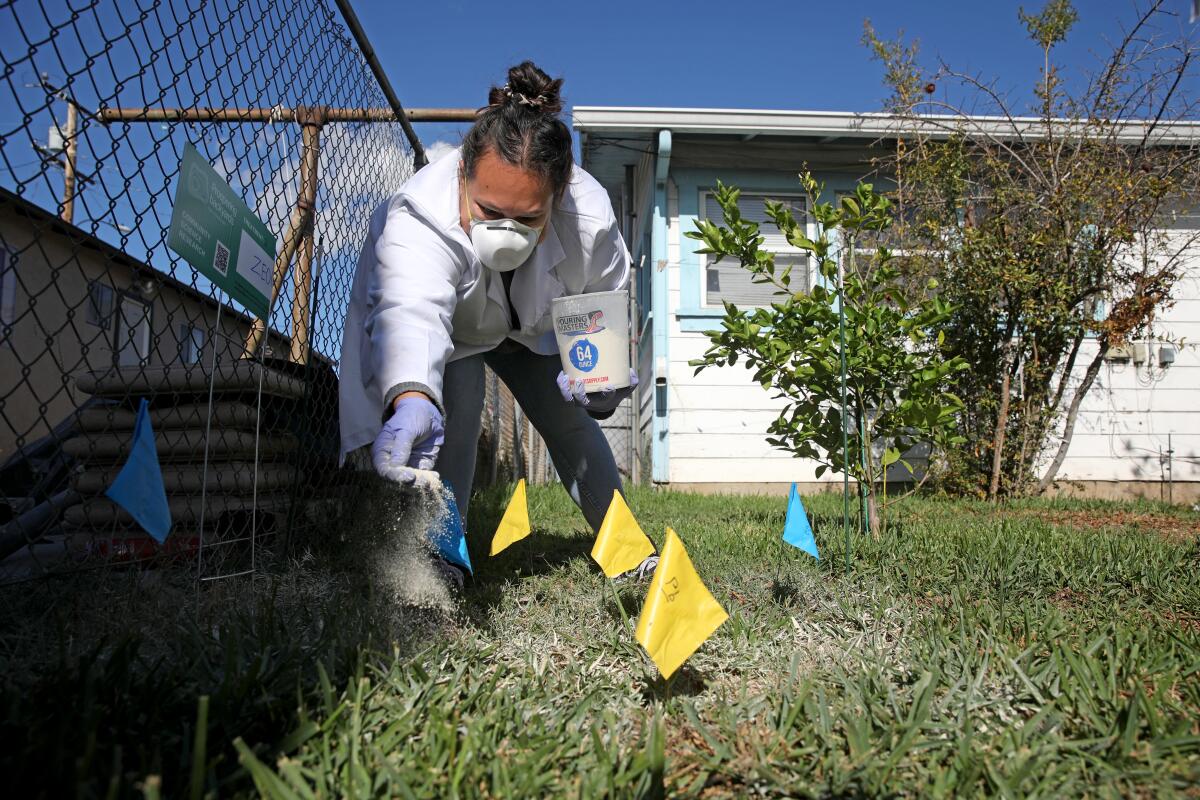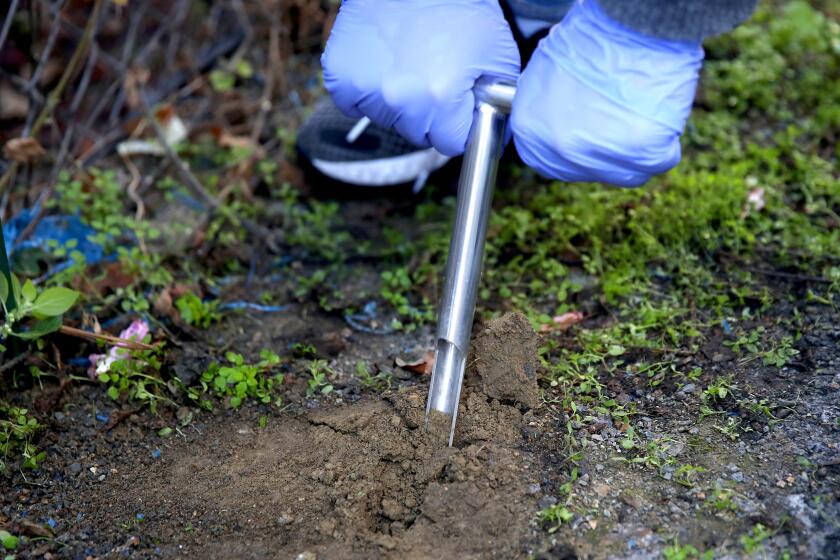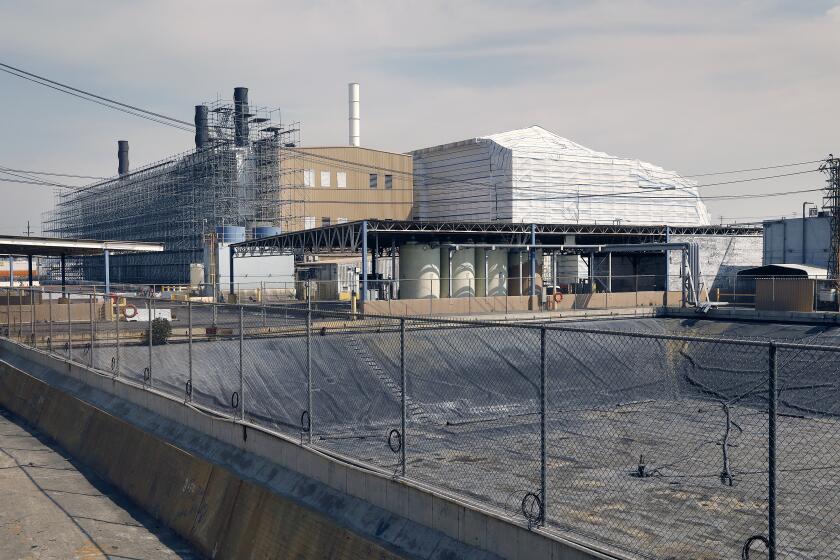State officials ‘vow to do better’ on Exide lead cleanup. Some residents aren’t satisfied

- Share via
The head of the state agency overseeing toxic substances said it must radically improve communication with residents living near the former Exide battery recycling plant in Vernon, where it is pursuing the largest environmental cleanup in California history.
The vow from the Department of Toxic Substances Control came in response to a Times investigation this month showing that numerous properties that had been remediated at great cost to state taxpayers were left with concentrations of lead in their yards in excess of state health standards.
Many community members and advocates, however, were unsatisfied with the pledge, with one resident dismissing it Thursday night as “another DTSC world apology tour.” They want the department to commit to improving not just its communication but also the way it has pursued the massive cleanup.
The Times reported that researchers at USC and Occidental College tested surface soils from the yards of 93 already remediated homes and found that 73 had at least one soil sample with lead concentrations over the California health threshold of 80 parts per million. The department’s own data show that contractors working for the state had failed to meet state cleanup targets at more than 500 of 3,370 cleaned properties near the closed Vernon facility, The Times reported.
DTSC Director Meredith Williams said department scientists could not comment on USC’s findings “until we see … the full results and methods used in the study.” Only then, she added, could officials “determine where there are problems that we need to resolve.”
Researchers have made their data public but said they have not provided results on individual properties because of federal rules governing the protection of human subjects who participate in research studies.
Nevertheless, Williams said it is “crystal clear” that “DTSC needs to improve how we communicate with you about our work and how it impacts you.” She said officials had always anticipated that “in some cases we cannot remove all of the contamination on a property” because of obstacles underground, such as pipes or foundations.
“We recognize that we haven’t been clear enough about what this means, and we vow to do better,” Williams said. In cases where lead is left behind, she added, the state “may need to come back and do more.”
Williams and her deputies unveiled their promises during a sometimes-raucous community meeting held on video Thursday evening. They said that beginning the week of March 6, officials will hold in-person meetings in Boyle Heights and southeast Los Angeles County cities to hear residents’ concerns about the cleanup and respond to them swiftly.
Numerous homes that underwent remediation have been left with lead concentrations in excess of state health standards, according to USC researchers.
Officials said they also now plan to reach out to renters, who make up a significant portion of the residents in the cleanup area, and not just property owners, to make them aware of the work going on at thousands of homes.
Many residents and advocates responded that this was not nearly enough.
“The amount of misinformation being given [tonight] is disgusting,” said mark! Lopez, a community organizer for East Yard Communities for Environmental Justice, which has spent years pushing the state for a more vigorous cleanup.
Lopez said state officials falsely claim they are providing appropriate oversight of contractors who were cleaning people’s yards, when “abuses run wild. We visited sites with your staff and witnessed violations with your staff while we were there.”
He also took umbrage at the idea that the state was committed to protecting the community, noting that officials had in the past tried to limit the number of homes that would be cleaned up and expanded the area only under pressure from county officials.
After the meeting, Jill Johnston, the USC associate professor of environmental health who is conducting soil testing in the area, noted that the state’s plan called for contractors to remove soil until its lead content was below 80 parts per million, and that workers were supposed to use shovels and other hand tools to excavate near trees and structures. “Surface soil was intended to be removed and replaced,” she said.
Tiff Sanchez, a youth organizer for East Yard, dismissed the meeting as “another DTSC world apology tour” and said it is “something that we’re quite frankly sick and tired of, literally and figuratively.”

In response to Sanchez, Todd Sax, the DTSC’s deputy director of site mitigation and restoration, said: “I hear you. I appreciate the anger. I understand we have a long way to go.”
Other residents aired specific complaints about the cleanup of their properties.
Andres Gonzalez, who lives in Maywood, recounted how he witnessed workers dumping contaminated dirt from a neighbor’s home into bushes in his yard.
“They had a large dump container that appeared to be full,” he said, adding that instead of getting another container, they got rid of the dirt in his yard. “When I stepped out the front door, I heard a loud ‘Oh, s—,’” he said.
Several employees of contracting crews doing the lead remediation work defended the job they were doing. Juan Flores, who is employed on a cleanup crew, said he views his work as “taking care of the community that’s been suffering for a long time.”
As many as 10,000 properties within 1.7 miles of a shuttered battery recycling plant may have been contaminated. Check your property’s cleanup status.
The $750-million cleanup effort — the largest and most costly in California history — was launched six years ago following the closure of the battery recycling plant after state officials determined that as many as 10,000 properties had been contaminated by pollution from the facility.
Officials had hoped Exide would pay for the cleanup, but the company was allowed to walk away from much of the financial obligation after filing for bankruptcy protection. Exide has argued in the past that it was not responsible for lead contamination in the surrounding neighborhoods, pointing to other sources such as lead paint.
State leaders have framed the massive cleanup as a measure of redress for neighborhoods subjected to decades of environmental degradation and government negligence. Many in the community were furious that the state allowed the plant to operate for so long despite a history of illegal air pollution and hazardous waste violations.
Faced with mounting costs for the cleanup, state officials have also appealed to the federal government to declare the shuttered plant and the area around it a Superfund site, which would clear the way for federal funds to support the cleanup.
Last week, members of Congress, including Rep. Robert Garcia (D-Long Beach) and Sens. Alex Padilla and Dianne Feinstein, called on the EPA to step in, citing The Times’ investigation.
In a statement, EPA officials said Friday that the agency “continues to work tirelessly to gather evidence” to support the state’s Superfund request and that EPA staff were in southeast Los Angeles County last week as part of that effort.
State Assemblymember Miguel Santiago (D-Los Angeles), who represents Boyle Heights and has pushed for more funding for the cleanup, said he would be monitoring the situation closely.
“There is zero room for excuses or error when it comes to cleaning our neighborhoods,” he said. “Anything less is not acceptable.”
More to Read
Sign up for Essential California
The most important California stories and recommendations in your inbox every morning.
You may occasionally receive promotional content from the Los Angeles Times.
















